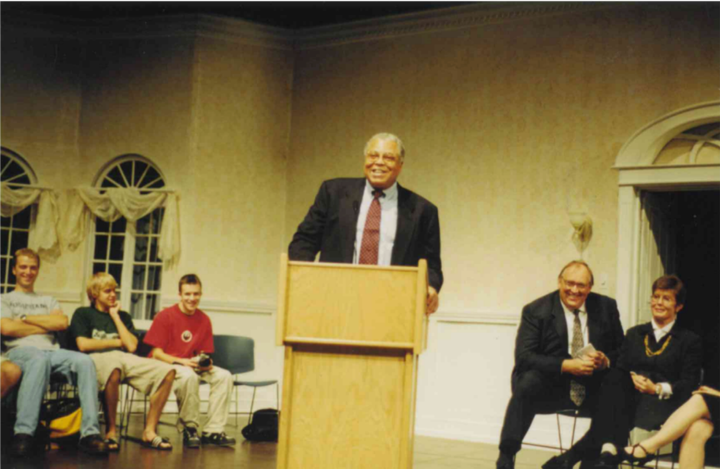Augustana athletics improved because of Oliver’s involvment

Oliver’s legacy will remain with AU athletics long after his retirement
Ryan Heuer
Augustana University President Rob Oliver wrote a letter to the editor, which the Argus Leader published in September 2012.
He wrote about the importance of athletics to a university — that the two complement each other and drive one another, but that academics takes precedence.
It’s a philosophy that will be a hallmark of his legacy long after he retires from his 11-year presidency in July.
Augustana’s athletic scene looked much different in 2006 when the school named Oliver as its 23rd president.
There was no giant football stadium serving as a symbol of Augustana’s athletic vision and ambitions.
There wasn’t a soccer field.
The school still competed in the North Central Conference, against schools like the University of South Dakota, which are now in Division I.
Oliver had a vision for the direction of Augustana athletics.
He made it a reality.
Support for learning, community
Oliver was a baseball player and both of his daughters were heavily involved in sports when they were in school, but his passion for Augustana athletics isn’t driven by a simple love for physical competition.
“Athletics are a great learning opportunity,” Oliver says. “There are things that one learns in athletics that I think are valuable life lessons: Understanding the commitment it takes to do something to the very best of your ability; understanding that we all play within a set of rules, even if the rules are inconvenient; there’s teamwork and playing a role.”
Oliver says that, through sports, all of these lessons can be learned in one setting. They prepare a student-athlete for life after college.
“These are all things that employers look for and say, ‘I need that skill on my team,’” he says.
Oliver also values athletics’ ability to enhance the Augustana community.
“Athletics is an area that friends of the university can join in on,” Oliver says. “They can be part of us. It’s an invitation that says, come and be with us … Come root for Augustana.”
Oliver anticipated 5,000 fans at the USF-Augustana football game, saying it was remarkable that that many people would be there to cheer on a comparatively small group of men.
There were more than 7,000 fans.
“Being able to gather the community in celebration of the institution is a neat opportunity,” Oliver says.
Equal opportunities
There are several cases, mostly in major Division I sports, of schools overlooking poor academic performance in order to keep student-athletes eligible for competition, such as the University of Minnesota men’s basketball scandal in the 1990s, or North Carolina’s in the 2000s.
That hasn’t remotely been the case at Augustana under Oliver’s watch.
“Athletics can be an important part of a collegiate experience, but academics is the reason for the experience,” he says, citing a phrase he heard at an NCAA meeting several years ago. “It’s when we put those together well that I think we’re doing our job. I look at it not as an either-or, but a both-and.”
Dean of Students Jim Bies says Oliver’s ability to cater to both academics and athletics will be his legacy.
In addition to the flourishing of the athletic programs, Augustana carried out the renovation of the Mikkelsen Library and the construction of the Froiland Science Complex under Oliver.
“[Balancing those] was the magic of it all,” Bies says.
“He’s shown his support outside of the classroom,” Augustana Director of Athletics Slade Larscheid says. “Being a student-athlete or being involved in the arts is such an important part of the culture at Augustana. Rob does it in such a genuine way.”
Making homes
Oliver has overseen the addition or renovation of several athletic facilities in his time as president.
The football team began playing at Kirkeby-Over Stadium in 2009 after years of playing off-campus. That same year, the soccer team opened Morstad Field, its first on-campus facility since the program’s inception in 2000.
Karras Park, which houses the baseball team, was renovated in 2010.
The Huether Tennis Centre was built in 2009.
An indoor track will arrive with the impending construction of the Student Activities Center.
These facilities all have something in common.
They’re on campus.
“Our athletes had to travel to compete [in Sioux Falls], and that wasn’t home,” Oliver says. “I really liked the notion that we could bring those activities, the pageantry and excitement of game day, back to campus.”
Oliver says his family’s athletic background was one reason he found it important to “build homes” for Augustana sports, citing one daughter who played soccer and ran cross-country; the other, tennis.
“I look at [Augustana student-athletes], and they’re all somebody’s daughter or son,” Oliver says. “There’s a mom and dad out there that wants to have the same sense of pride that a football parent might have. I wanted to invest in those [other] programs so that those students would feel equally important.”
Chances are if you go to an event in one of these “homes,” you’ll see Oliver there.
“He’s such a genuine fan of Augustana athletics,” Larscheid says. “That’s the key to this. He supports all of our sports, not just one or the other. It’s not a job or a duty for him to go athletic events. He’s a genuine fan.”
Bies says he and Oliver have had several conversations since Oliver announced his intention to retire, and that the president is as focused as ever at finishing work yet to be done.
“This institution will go on long after I’m gone,” Oliver says.
So, too, will his legacy.



